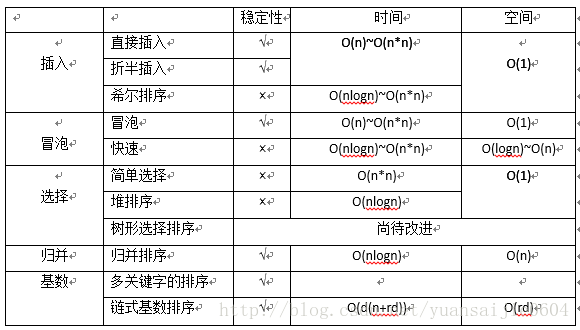数据结构(严蔚敏)第十章:内部排序
直接插入
//直接插入:左边有序,右边无序,从右边取数依次插入有序中
void InsertSort(int List[],int len){
for(int i=1;iif(List[i-1]>List[i]){
int temp=List[i];//此temp可在数组中留出List[0]作为哨兵
//有序数组后移
int j=i;
for(;j>0&&List[j-1]>temp;--j){List[j]=List[j-1];}
List[j]=temp;
}
}
} 折半插入
//折半插入:插入点采用折半查找的方式
void InsertSort2(int List[],int len){
for(int i=1;iif(List[i-1]>List[i]){
int temp=List[i]; //此temp可在数组中留出List[0]作为哨兵
int low=0,high=i-1,mid=0;
while(low2;
if(List[mid]>temp) high=mid-1;
else low=mid+1;
}
for(int j=i-1;j>=low;--j){List[j+1]=List[j];}
List[low]=temp;
}
}
} 希尔排序
//希尔排序,定步长距离d,List[i]和List[i+d]进行大小交换
//步长选择都是从n/2开始,每次再减半,直到最后为1。其实也可以有另外的更高效的步长选择
void shellsort1(int a[], int n)
{
int i, j, gap;
for (gap = n / 2; gap > 0; gap /= 2) //步长
for (i = 0; i < gap; i++){ //直接插入排序
for (j = i + gap; j < n; j += gap)
if (a[j] < a[j - gap]){
int temp = a[j];
int k = j - gap;
while (k >= 0 && a[k] > temp){
a[k + gap] = a[k];
k -= gap;
}
a[k + gap] = temp;
}
}
}
void shellsort2(int a[], int n)
{
int j, gap;
for (gap = n / 2; gap > 0; gap /= 2)
for (j = gap; j < n; j++)//从数组第gap个元素开始
//每个元素与自己组内的数据进行直接插入排序
if (a[j] < a[j - gap])
{
int temp = a[j];
int k = j - gap;
while (k >= 0 && a[k] > temp)
{
a[k + gap] = a[k];
k -= gap;
}
a[k + gap] = temp;
}
}
//希尔排序代码简洁版
void ShellSort3(int List[],int len){
for(int gap=len/2;gap>0;gap/=2)
for(int i=gap;ifor(int j = i - gap; j >= 0 && List[j] > List[j + gap]; j -= gap)
swap(List[j],List[j+gap]);
}
冒泡排序
//冒泡排序
void BubbleSort(int List[],int len){
int flag;
for(int times=0;timestimes++){
flag=0;
for(int i=1;itimes;i++){
if(List[i-1]>List[i]) {
swap(List[i],List[i-1]);flag=1;
}
}
if(flag==0) break;
}
}
快速排序
//快速排序(递归):选取第一个数为轴心点
int Partition(int List[],int low,int high){
int pivotkey=List[low];
while(low!=high){
//先从右边开始找
while(lowList[high]>=pivotkey) --high;
List[low]=List[high];
while(lowList[low]<=pivotkey) ++low;
List[high]=List[low];
}
List[low]=pivotkey;
return low;
}
//low为0,high为len-1
void QuickSort(int List[],int low,int high){
if(lowList,low,high);
QuickSort(List,low,pivot-1);
QuickSort(List,pivot+1,high);
}
} 简单选择排序
//简单选择排序:在后面数组中选择最小的插入前面的交换
void SelectSort(int List[],int len){
for(int k=0;k<len-1;k++){
int j=k;
for(int i=k+1;i<len;i++){
if(List[i]if(j!=k) swap(List[k],List[j]);
}
} 堆排序
//堆排序:将欲排数组构建成完全二叉树,从n/2开始调整堆(逻辑存储是二叉树,物理存储是顺序表)
void AdjustHeap(int List[],int i,int len){
//i节点的左右孩子是2*i+1,2*i+2
int temp=List[i];
int j=2*i+1;
while(j<len){
//j为左右子节点中最大的位置
if(j+1<len&&List[j+1]>List[j]) j++;
if(List[j]<=temp) break;
List[i]=List[j];
//下一层要检查比较
i=j;
j=2*i+1;
}
List[i]=temp;
}
//一次调整,能得到最大的
void MakeMaxHeap(int List[],int len){
for(int i=len/2-1;i>=0;i--){
AdjustHeap(List,i,len);
}
}
//建大顶堆的话,每一次建堆,会选出最大的,和最后面的对换,再只要调整头,则能得到第二大的,再和倒数的对换,能得到一个递增的数组
void HeapSort(int List[],int len){
for(int i=len/2-1;i>=0;i--){
AdjustHeap(List,i,len);
}
for(int j=len-1;j>0;j--){
swap(List[0],List[j]);
AdjustHeap(List,0,j);
}
}归并算法
//归并算法
//将有二个有序数列a[first...mid]和a[mid...last]合并。
void mergearray(int a[], int first, int mid, int last, int temp[]){
int i = first, j = mid + 1;
int m = mid, n = last;
int k = 0;
while (i <= m && j <= n){
if (a[i] <= a[j])
temp[k++] = a[i++];
else
temp[k++] = a[j++];
}
while (i <= m) temp[k++] = a[i++];
while (j <= n) temp[k++] = a[j++];
for (i = 0; i < k; i++) a[first + i] = temp[i];
}
void mergesort(int a[], int first, int last, int temp[]){
if (first < last){
int mid = (first + last) / 2;
mergesort(a, first, mid, temp); //左边有序
mergesort(a, mid + 1, last, temp); //右边有序
mergearray(a, first, mid, last, temp); //再将二个有序数列合并
}
}
bool MergeSort(int a[], int n){
int *p = new int[n];
if (p == NULL)
return false;
mergesort(a, 0, n - 1, p);
delete[] p;
return true;
----------
}文档版和cpp版下载
-
- 直接插入
- 折半插入
- 希尔排序
- 冒泡排序
- 快速排序
- 简单选择排序
- 堆排序
- 归并算法
